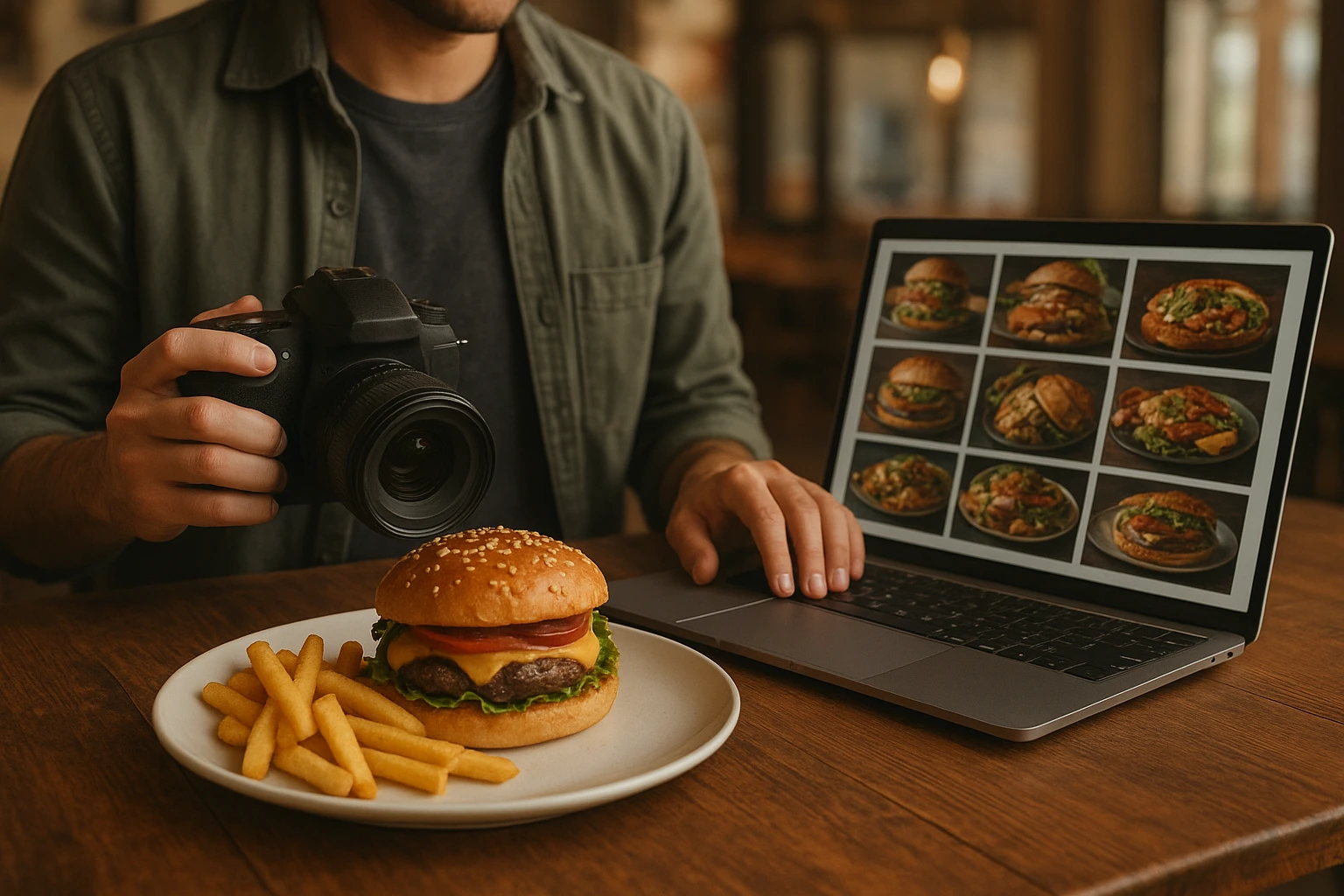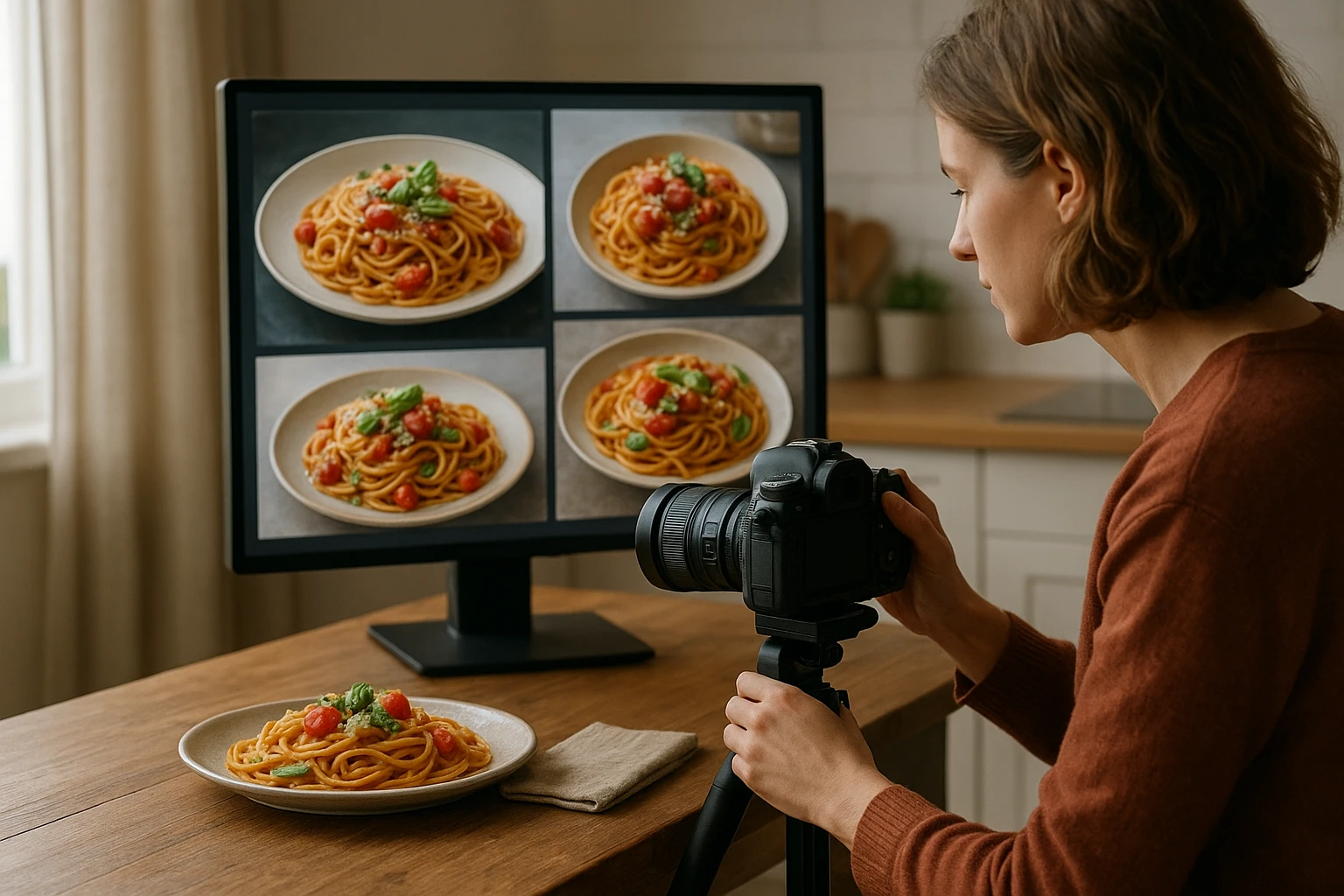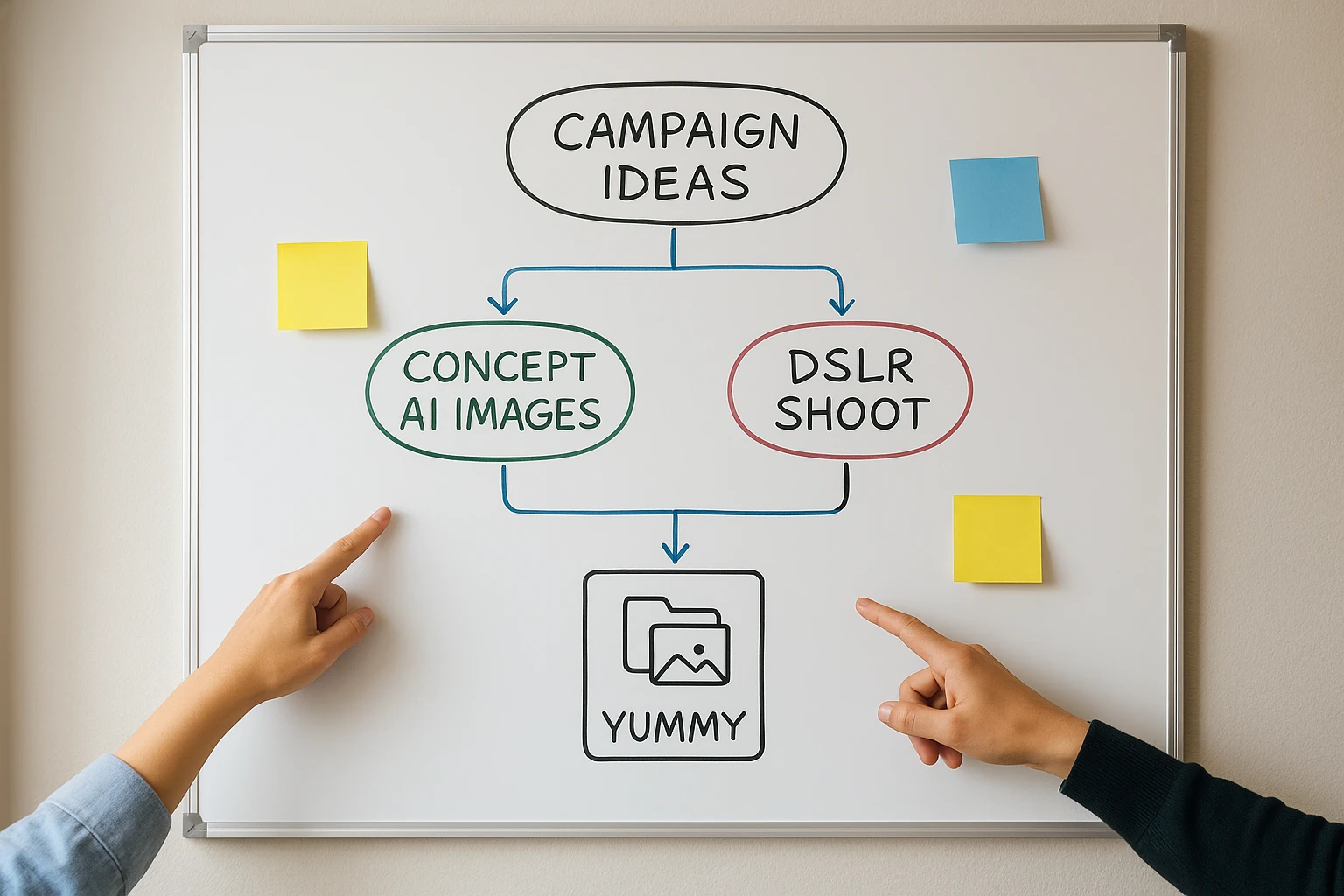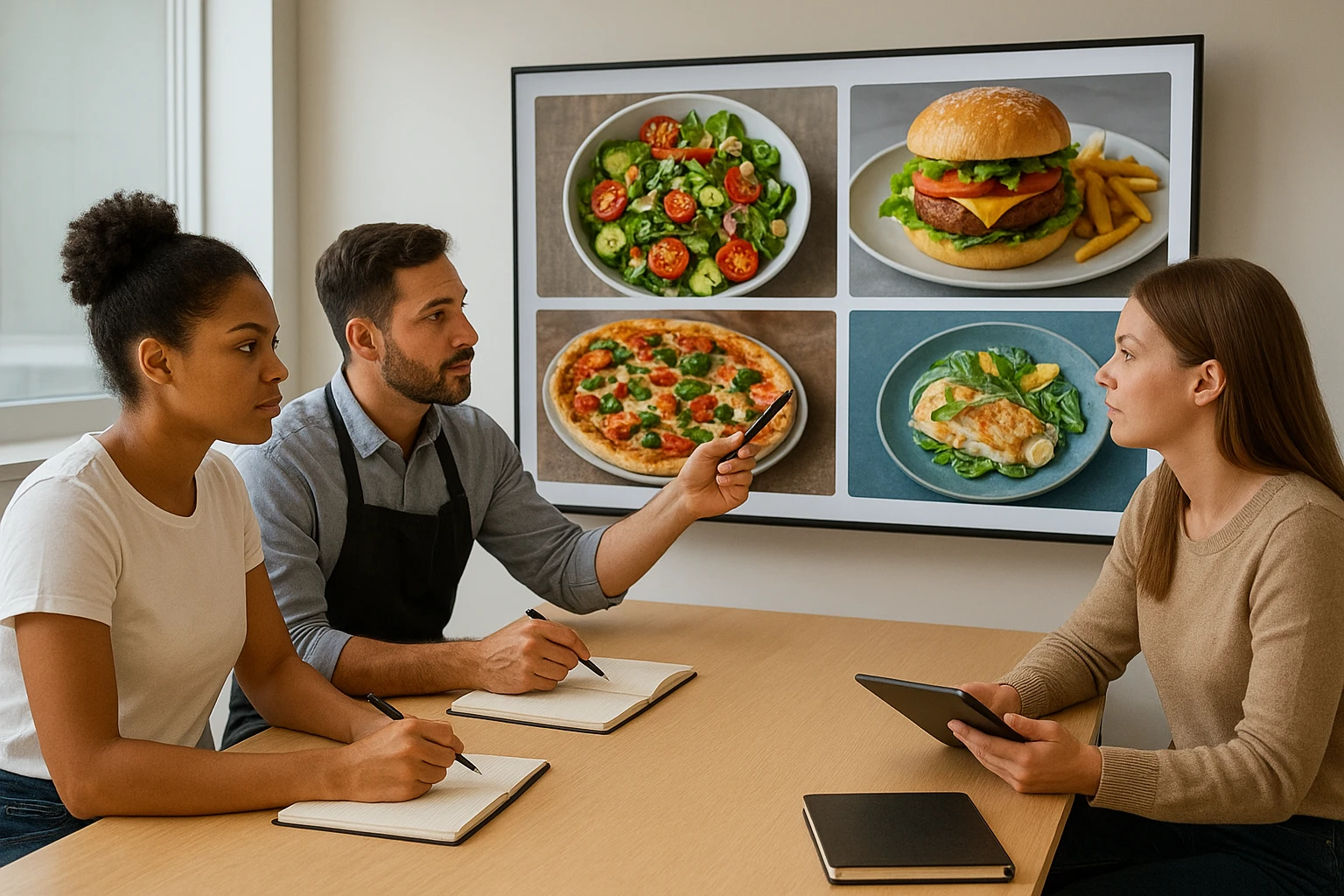Why Food Bloggers Are Ditching DSLR Cameras for AI

Quick navigation:
- 1. The New Food Photo Dilemma: Real Plate or Rendered Pixel?
- 2. Where AI Already Beats DSLR-for Speed, Concepting, and Volume
- 3. Why Many Bloggers Still Swear by DSLR (and When You Should Too)
- 4. Designing a Hybrid Workflow: AI + DSLR + Yummify
- 5. Future-Proofing Your Visual Strategy (So You Don’t Regret Today’s Shortcuts)
1. The New Food Photo Dilemma: Real Plate or Rendered Pixel?
A few years ago, the big question for food bloggers was whether to invest in a DSLR body or squeeze a bit more out of their phones. Now operators are facing a tougher version of that same decision: buy a DSLR, hire a photographer, or let AI whip up an entire menu’s worth of visuals overnight.
Food bloggers were early to this shift. Many still shoot their cornerstone recipes on DSLR, but they’ll use AI food photography to test seasonal ideas, mock up sponsored posts, or keep social feeds moving between big shoots. Restaurant marketers are starting to follow that pattern-but with different stakes. Your visuals don’t just win likes; they influence bookings, delivery conversion, and guest expectations.
According to Gartner’s 2023 Hype Cycle for Generative AI, generative AI has blasted through early adoption and is now in everyday business workflows. In parallel, HubSpot’s State of AI in 2024 reports that marketers are using AI primarily for content and creative production-exactly where food imagery sits. That’s why we’re refreshing the original original DSLR vs AI feature: the decision is no longer theoretical.
How this debate looks from an operator’s point of view
Imagine a neighborhood cafe with:
- A new brunch menu launching in 10 days
- Zero recent photos of updated plates
- A stretched budget after a slow winter
Option A: hire a photographer, spend $2,000-$3,000, and likely miss the launch date. Option B: DIY smartphone photos that don’t look like the food blogger shots your guests are used to. Option C: follow what many food bloggers are doing-capture a few anchor dishes with a DSLR (or a single paid shoot), then use AI to explore compositions and campaign concepts in hours, not weeks.
Food bloggers and AI tools proved there’s a middle ground. With platforms like Yummify, operators can upload a decent reference photo, apply a reusable branded environment, and get consistent, styled images without rebuilding a studio every time.
Quick gut-check: are you chasing accuracy or experimentation?
Use this simple checklist to orient your decisions:
- If your top goal is bookings and menu clarity: lean DSLR/real food first; use AI only to style backgrounds or create lifestyle scenes around real dishes.
- If your top goal is brand and concept testing: let AI lead for moodboards, social tests, and advertising mockups, with clear internal labels.
- If you’re under intense time and budget pressure: start AI-first for social and website banners, then schedule a smaller DSLR shoot for 5-10 must-have dishes.
- If you run a high-trust concept (fine dining, allergy-sensitive): keep AI on a tight leash-no AI hero shots on menus or delivery platforms.
Pause and write down your top channel (menu, delivery, social) and main goal; you’ll use it to choose between DSLR, AI, or a hybrid workflow in the next sections.
Summary: Section 1 reframes DSLR vs AI as a business decision for operators, not a tech debate, explaining how generative AI has moved into daily marketing work and why a refreshed AI vs DSLR comparison matters now.

2. Where AI Already Beats DSLR-for Speed, Concepting, and Volume
Food bloggers were the first to discover that AI isn’t a full DSLR replacement-it’s the assistant that never sleeps. Operators can borrow that approach for very specific scenarios where AI food photography is already the smarter first move.
According to the US Copyright Office, AI-generated imagery typically doesn’t qualify for traditional copyright protection unless there’s significant human authorship. That’s a signal: treat AI images as flexible, disposable assets for testing and concepting-not as your forever brand library.
Four high-impact AI use cases borrowed from food bloggers
-
Concepting new menus before dishes exist
Bloggers will prototype “dream recipes” in AI before shopping for ingredients. Operators can do the same: use Yummify to generate styled mockups of a spring pasta line or a new dessert flight while the kitchen is still dialing in the recipes. -
Seasonal and LTO social campaigns
Instead of booking a full shoot for a three-week pumpkin special, generate 10-20 AI variations around one decent reference shot. You can test different environments-cozy cafe, minimal studio, outdoor picnic-then upgrade only the best performers. -
Filler content and lifestyle scenes
Bloggers don’t photograph every latte; they pair hero shots with AI table scenes and ingredient flat-lays. You can generate branded overheads of a shared table, or a night-time patio vibe, while keeping actual dishes represented with real photos. -
A/B testing creative directions
In one PetaPixel comparison, a photographer found that AI versions of his burger shot were “scary close” to his real images and sometimes preferred in blind tests (PetaPixel). Use that insight to test layout and lighting styles cheaply-then commit to DSLR for the final ad or menu hero.
Operator checklist: when AI is the smart first move
- You’re promoting a dish that may change or disappear after a short run.
- You need assets for social or email in days, not weeks.
- You’re exploring visual directions for a rebrand or new concept.
- You want 3-5 versions of the same theme for paid ads or website tests.
- You’re comfortable labeling AI imagery internally as NOT FOR MENUS/DELIVERY.
How Yummify fits into this AI-first layer
Borrow a food blogger’s workflow and adapt it for your team:
- Start with a reference - Snap a decent smartphone photo near a window. Upload to Yummify.
- Apply a branded environment - Save your go-to look (e.g., “Neon ramen bar” or “Rustic bakery”) so every AI concept feels on-brand.
- Generate batches - Spin up 8-12 variations for a campaign, then shortlist 2-3 for real use.
- Tag clearly - In your Yummify folders, label these as AI + SOCIAL/ADS ONLY so they never accidentally land on third-party delivery platforms.
Want to see how close AI can get to real food photography? Watch this comparison:
Next: List two upcoming campaigns where AI-generated visuals could help you test ideas or fill content gaps without booking a full shoot.
Summary: Section 2 shows where AI already outperforms DSLR for operators-concepting, seasonal campaigns, filler content, and A/B tests-and outlines a practical, AI-first workflow using Yummify while keeping risky contexts off-limits.

3. Why Many Bloggers Still Swear by DSLR (and When You Should Too)
Food bloggers haven’t thrown their DSLR kits in the trash. They’ve just become more selective. The same logic applies to operators: there are moments where DSLR food photography-or at least honest photos of your real dishes-is non?negotiable.
Where real plates still beat rendered pixels
-
Menus and table talkers
Guests treat menu photos as a promise. Over-idealized AI can backfire when the plate hits the table looking smaller, darker, or just different. Bloggers know this from reader backlash on “Pinterest vs reality” moments. -
Third?party delivery platforms
If your DoorDash thumbnail shows a towering burger and the driver drops off a flatter version in different packaging, you risk refunds and negative reviews. That’s why many operators still commission DSLR shots specifically for delivery. -
Signature dishes and allergen?sensitive items
For your famous ribeye or gluten?free pizza, texture and detail matter. You may need to show char, crust, or toppings accurately to avoid misunderstandings.
According to the US Copyright Office’s AI guidance, only the human-authored aspects of a work are eligible for copyright. That’s a major reason bloggers and brands still invest in DSLR: they want clear ownership and licensing rights. Terms from popular AI tools echo this nuance-Midjourney’s Terms of Service explain that while users get broad usage rights, the company can use generated images for training and may not grant exclusive control. For operators, that means DSLR images from a photographer can be fully owned and licensed; AI images are more like shared materials.
Decision matrix: when DSLR is non?negotiable
| Use Case | Risk if AI Misleads | Recommended Approach |
|---|---|---|
| In?restaurant printed menus | Guest disappointment, complaints, and potential scrutiny in some markets | Use DSLR or real photos only; AI allowed only for background styling |
| Delivery platforms | Chargebacks, negative reviews, and platform issues if food looks different | Use recent DSLR shots of actual portions and packaging; store and date-tag them in Yummify |
| Website hero sections | Unrealistic expectations of plating and ambiance | Mix DSLR for key dishes with AI ambience; label sources internally |
| Organic social | An over-polished feed that doesn’t match reality | Mostly real shots; sprinkle in AI for lifestyle and concept posts |
| Paid ads and billboards | Higher risk of reputational damage if claims feel deceptive | Use DSLR for hero dishes; use AI only in early mockups and layout tests |
How Yummify supports DSLR-first areas
- Upload DSLR shots as MENU-APPROVED and DELIVERY-APPROVED categories.
- Store plate notes with each image (portion size, allergens, last update date).
- Generate AI variations strictly for backgrounds or lifestyle use, tagged as such.
Next: Audit your current visuals: mark which images must remain true-to-plate and flag where AI is strictly off-limits in your brand standards.
Summary: Section 3 explains why food bloggers still rely on DSLR for critical work and shows operators where real food photos are non-negotiable, tying the argument to copyright realities and a practical use-case matrix.

4. Designing a Hybrid Workflow: AI + DSLR + Yummify
Food bloggers who publish three times a week don’t choose between AI and DSLR; they design a workflow where each has a job. Operators can use the same mindset-and Yummify-to keep restaurant marketing visuals consistent without burning budget.
Five-step hybrid workflow for food operators
-
Map your channels and goals
Decide what each channel is for. Example: menus and delivery = accuracy; social and email = storytelling; website hero = a mix. -
Assign a default visual source
- Menus, delivery, allergen-sensitive: DSLR/real only.
- Organic social, concepts, moodboards: AI-first.
- Website and ads: hybrid, tested case by case.
-
Create one shared visual brief
Bloggers have presets; you can have a Yummify brief template: brand colors, surfaces, utensils, negative space rules, and no-go items (e.g., no fake steam, no over-melted cheese). -
Produce in batches
- Quarterly: run a DSLR shoot for 10-20 must-have dishes.
- Monthly: use Yummify to generate AI variations, lifestyle scenes, and tests.
-
Centralize, tag, and review
Upload everything into Yummify with tags like AI, DSLR, MENU-APPROVED, SOCIAL-ONLY, and campaign names. Review performance monthly and shift your mix-more DSLR where trust issues appear, more AI where speed matters.
Sample weekly rhythm inspired by food bloggers
- Monday: plan posts; list which need real vs AI imagery.
- Tuesday: kitchen snaps reference photos; upload to Yummify for AI styling.
- Wednesday: schedule posts using approved assets.
- Thursday-Sunday: capture one or two real guest moments or behind-the-scenes shots to refresh your library.
This rhythm mirrors how prolific bloggers operate-mixing polished DSLR recipes with quicker concepts-just packaged into Yummify workflows so staff always know what’s safe to use where.
Next: Sketch a quick version of this five-step workflow and adapt it to your team-then decide what you’ll test with AI in the next 30 days.
Summary: Section 4 turns the AI vs DSLR debate into a concrete five-step hybrid workflow using Yummify as the hub, borrowing habits from food bloggers so operators can scale visuals without chaos.

5. Future-Proofing Your Visual Strategy (So You Don’t Regret Today’s Shortcuts)
AI is improving quickly, and regulations are trying to keep up. What’s safe or standard now for food bloggers and AI might feel sloppy or deceptive in two years if you don’t set guardrails.
Why you need visual guardrails today
-
Expectations are rising
As more brands experiment with generative AI, audiences will get better at spotting over-polished images. Some will accept it for mood pieces; many will resent it on menus. -
Policies and laws are evolving
According to the US Copyright Office’s AI guidance, the legal treatment of AI-generated work is still in flux. And research on generative AI from firms like Gartner suggests we’re still moving through hype toward more scrutiny and regulation. -
Platforms can change rules overnight
Delivery marketplaces and social channels can update their policies around AI imagery at any time. Because terms differ by platform and are updated frequently, you should always check current guidelines before uploading AI photos.
Future-proof visual standards: quick guardrail checklist
- Document where AI is allowed (e.g., social concepts, lifestyle fillers) and where it isn’t (menus, delivery listings, allergen-sensitive dishes).
- Decide how you’ll disclose AI use-for example, a small “AI-styled concept” note on certain posts.
- Set minimum quality standards for all images: realistic portions, true-to-life colors, no impossible garnishes.
- Create an approval workflow inside Yummify so any new template or agency upload is reviewed before publishing.
- Schedule a quarterly purge of outdated or misleading images.
Let Yummify act as your memory
Food bloggers can keep rules in their heads; restaurant teams churn. Use Yummify as your source of truth: clear tags for AI vs DSLR, notes on where each image can be used, and a simple history of what’s been updated. That way, the standards you set now will still guide whoever is handling your visuals a year from today.
Next: Write one sentence that defines your brand’s promise around visual honesty, and use it to guide every AI vs DSLR decision going forward.
Summary: Section 5 looks ahead, explaining why operators need clear guardrails around AI imagery now and how Yummify can store those rules so future staff make consistent, trustworthy choices.

Next steps
If you’re torn between buying a DSLR, hiring a photographer, or leaning on AI, start small: choose five hero dishes for real photography, then use Yummify to generate AI concepts and social fillers around them. Map where each type of image is allowed (menus, delivery, social), tag your assets clearly, and review results in 30 days. You’ll have real data on how AI food photography and DSLR work together for your restaurant-without overcommitting budget or risking guest trust.
FAQ
Can I legally own and license AI-generated food photos like DSLR images?
AI-generated images are treated differently from traditional photography in most legal systems right now. According to the US Copyright Office, only the human-authored parts of a work qualify for copyright, which means fully automated AI food photos may not enjoy the same protection as a photographer’s DSLR shots. Many AI platforms grant you broad usage rights but keep some ability to reuse your images for training or promotion, and they usually don’t promise exclusivity. For example, Midjourney’s Terms of Service explain that the service can reuse generated images and that copyright status can vary by jurisdiction. Because of this, treat AI images as flexible marketing assets and reserve DSLR shoots (where you secure clear contracts with photographers) for visuals you need to fully own and reuse long term.
Will guests actually notice-or care-if my photos are AI-generated?
Some guests will never know, but many will notice when AI food photography crosses into fantasy-perfect drips, impossible portions, or props that don’t exist in your restaurant. The risk isn’t just being ‘caught’ using AI; it’s the gap between what people see online and what lands on their table. If a guest feels misled, they’re more likely to complain or leave a negative review, even if the food tastes good. A practical approach is to use AI for mood and lifestyle scenes while keeping anything that promises a specific plate-menus, delivery thumbnails-as honest photos of your real dishes. When in doubt, a small disclosure like “AI-styled concept” on social posts can signal creativity without deception.
Is it safe to use AI-generated images on delivery platforms like Uber Eats or DoorDash?
Safety here mostly comes down to accuracy and platform rules, which can change frequently. If your AI image exaggerates portion size, toppings, or packaging, you increase the chances of refunds, low ratings, or complaints when customers receive something different. Some marketplaces may also update policies about AI or heavily edited photos, so it’s smart to check each platform’s current guidelines before uploading new imagery. A conservative strategy is to use AI only for internal testing or social campaigns, and rely on honest DSLR or high-quality real photos for any listing where guests are making a purchase decision. That way, your delivery thumbnails function like a contract with the customer rather than a concept sketch.
How can a small operator with no photography experience run a hybrid AI + DSLR workflow?
You don’t need to be a pro photographer; you just need a simple system. Start by booking a modest shoot-maybe 8-10 key dishes-with a local photographer or skilled food blogger, and make those your non-negotiable hero images. Then take basic but well-lit smartphone photos of new items, upload them to Yummify, and use AI styling in your branded environments to create campaign variations and social fillers. Tag everything clearly (AI vs DSLR, menu-approved vs social-only) so your team doesn’t mix contexts. Over time, you’ll find a rhythm where quarterly DSLR shoots handle accuracy and Yummify handles speed and volume.
What happens if AI platforms change their terms-will my old images become a problem?
AI tools regularly update their terms around training data, attribution, and usage rights, which can affect how you’re allowed to use newly generated images. Existing images you’ve already downloaded are usually safe to keep using under the terms in place when you created them, but that isn’t guaranteed and may vary by service. Gartner’s research on generative AI notes that policy and governance are fast-moving areas, and Midjourney’s Terms of Service explicitly reserve the right to change conditions. To reduce risk, archive important AI assets in Yummify with notes on when and how they were created, and prioritize DSLR or fully owned photos for long-lived assets like menus and packaging. When terms change, you can quickly identify which campaigns might need updated visuals.
How should I disclose AI use in my marketing to stay ethical?
There is no single global rule yet, but transparency is the safest posture. For creative or clearly conceptual images on social, a simple caption note such as “AI-styled concept” or “visual mockup” is usually enough to avoid confusion. For anything that functions as a promise-a menu photo, delivery thumbnail, or in-store poster-aim to show real dishes and keep AI limited to background or ambience. The US Copyright Office’s AI guidance highlights how important human authorship and clear attribution are becoming, which suggests regulators may take a closer look at transparency in the future. Writing a short internal policy on when and how to disclose AI use, and storing it alongside your assets in Yummify, will help keep your team aligned as norms evolve.


